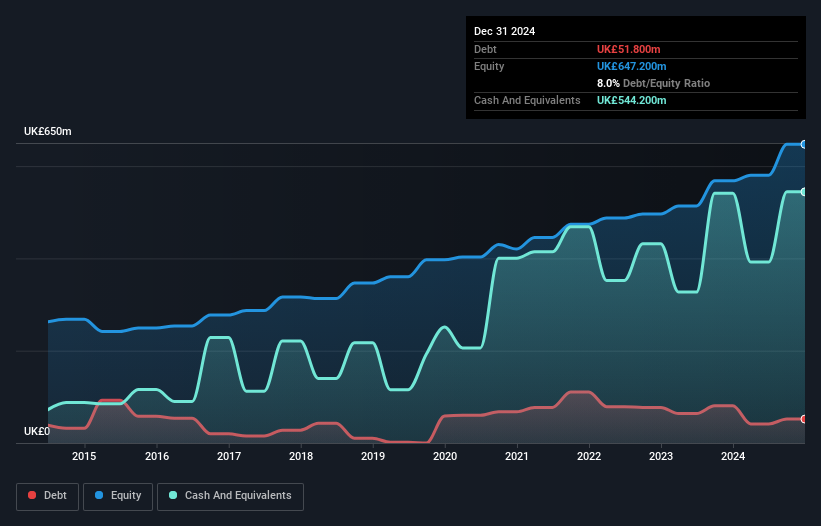- United Kingdom
- /
- Construction
- /
- LSE:MGNS
We Think Morgan Sindall Group (LON:MGNS) Can Manage Its Debt With Ease
The external fund manager backed by Berkshire Hathaway's Charlie Munger, Li Lu, makes no bones about it when he says 'The biggest investment risk is not the volatility of prices, but whether you will suffer a permanent loss of capital.' When we think about how risky a company is, we always like to look at its use of debt, since debt overload can lead to ruin. We can see that Morgan Sindall Group plc (LON:MGNS) does use debt in its business. But should shareholders be worried about its use of debt?
We've discovered 1 warning sign about Morgan Sindall Group. View them for free.Why Does Debt Bring Risk?
Debt is a tool to help businesses grow, but if a business is incapable of paying off its lenders, then it exists at their mercy. Ultimately, if the company can't fulfill its legal obligations to repay debt, shareholders could walk away with nothing. While that is not too common, we often do see indebted companies permanently diluting shareholders because lenders force them to raise capital at a distressed price. By replacing dilution, though, debt can be an extremely good tool for businesses that need capital to invest in growth at high rates of return. When we examine debt levels, we first consider both cash and debt levels, together.
What Is Morgan Sindall Group's Debt?
The image below, which you can click on for greater detail, shows that Morgan Sindall Group had debt of UK£51.8m at the end of December 2024, a reduction from UK£80.6m over a year. However, it does have UK£544.2m in cash offsetting this, leading to net cash of UK£492.4m.

How Strong Is Morgan Sindall Group's Balance Sheet?
Zooming in on the latest balance sheet data, we can see that Morgan Sindall Group had liabilities of UK£1.40b due within 12 months and liabilities of UK£83.2m due beyond that. Offsetting these obligations, it had cash of UK£544.2m as well as receivables valued at UK£668.6m due within 12 months. So its liabilities outweigh the sum of its cash and (near-term) receivables by UK£270.6m.
Given Morgan Sindall Group has a market capitalization of UK£1.65b, it's hard to believe these liabilities pose much threat. However, we do think it is worth keeping an eye on its balance sheet strength, as it may change over time. While it does have liabilities worth noting, Morgan Sindall Group also has more cash than debt, so we're pretty confident it can manage its debt safely.
Check out our latest analysis for Morgan Sindall Group
In addition to that, we're happy to report that Morgan Sindall Group has boosted its EBIT by 40%, thus reducing the spectre of future debt repayments. There's no doubt that we learn most about debt from the balance sheet. But ultimately the future profitability of the business will decide if Morgan Sindall Group can strengthen its balance sheet over time. So if you're focused on the future you can check out this free report showing analyst profit forecasts.
Finally, a business needs free cash flow to pay off debt; accounting profits just don't cut it. Morgan Sindall Group may have net cash on the balance sheet, but it is still interesting to look at how well the business converts its earnings before interest and tax (EBIT) to free cash flow, because that will influence both its need for, and its capacity to manage debt. Over the most recent three years, Morgan Sindall Group recorded free cash flow worth 78% of its EBIT, which is around normal, given free cash flow excludes interest and tax. This cold hard cash means it can reduce its debt when it wants to.
Summing Up
Although Morgan Sindall Group's balance sheet isn't particularly strong, due to the total liabilities, it is clearly positive to see that it has net cash of UK£492.4m. And we liked the look of last year's 40% year-on-year EBIT growth. So we don't think Morgan Sindall Group's use of debt is risky. The balance sheet is clearly the area to focus on when you are analysing debt. However, not all investment risk resides within the balance sheet - far from it. Be aware that Morgan Sindall Group is showing 1 warning sign in our investment analysis , you should know about...
If, after all that, you're more interested in a fast growing company with a rock-solid balance sheet, then check out our list of net cash growth stocks without delay.
New: Manage All Your Stock Portfolios in One Place
We've created the ultimate portfolio companion for stock investors, and it's free.
• Connect an unlimited number of Portfolios and see your total in one currency
• Be alerted to new Warning Signs or Risks via email or mobile
• Track the Fair Value of your stocks
Have feedback on this article? Concerned about the content? Get in touch with us directly. Alternatively, email editorial-team (at) simplywallst.com.
This article by Simply Wall St is general in nature. We provide commentary based on historical data and analyst forecasts only using an unbiased methodology and our articles are not intended to be financial advice. It does not constitute a recommendation to buy or sell any stock, and does not take account of your objectives, or your financial situation. We aim to bring you long-term focused analysis driven by fundamental data. Note that our analysis may not factor in the latest price-sensitive company announcements or qualitative material. Simply Wall St has no position in any stocks mentioned.
About LSE:MGNS
Morgan Sindall Group
Operates as a construction and regeneration company in the United Kingdom.
Outstanding track record with flawless balance sheet and pays a dividend.
Similar Companies
Market Insights
Community Narratives



